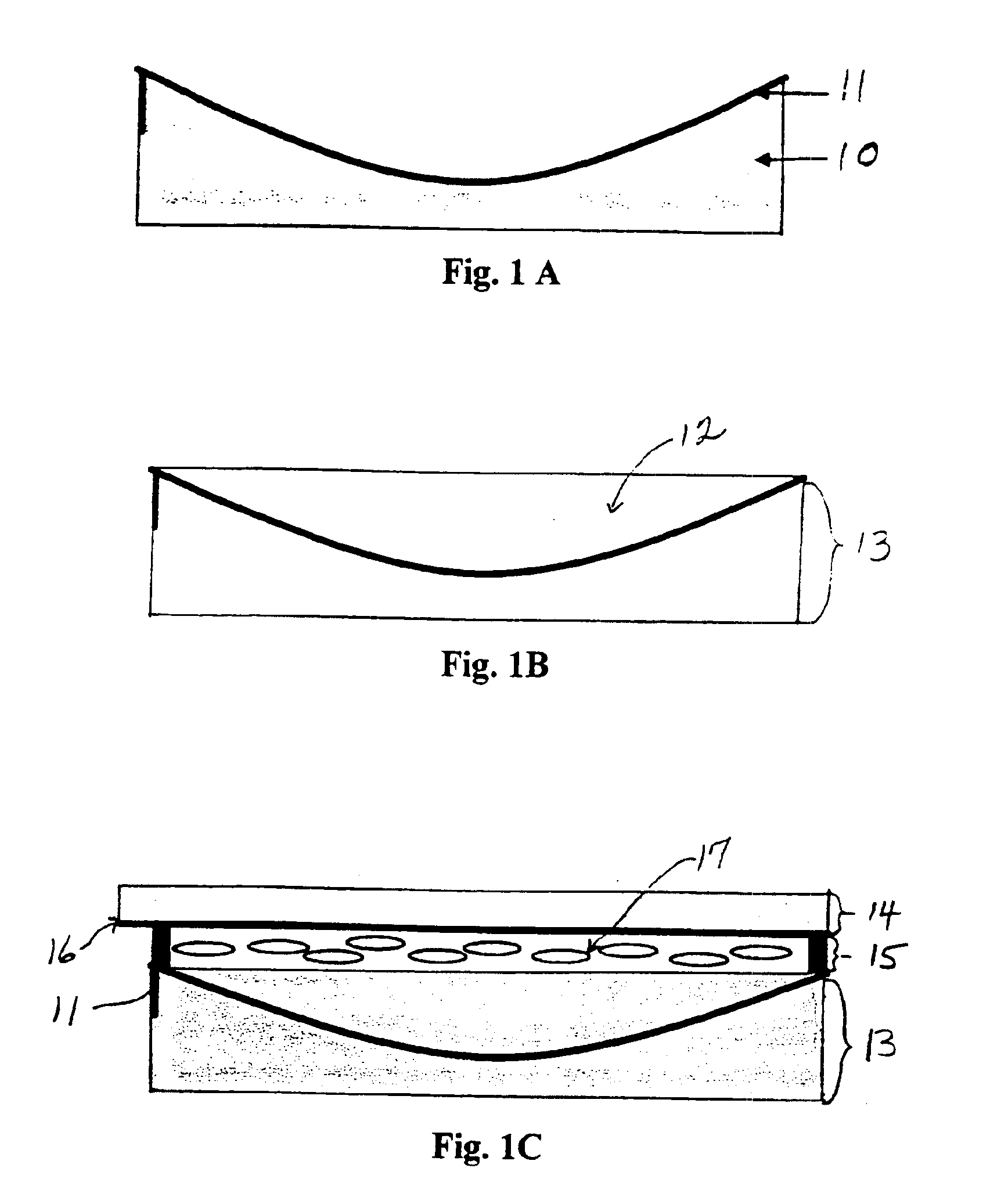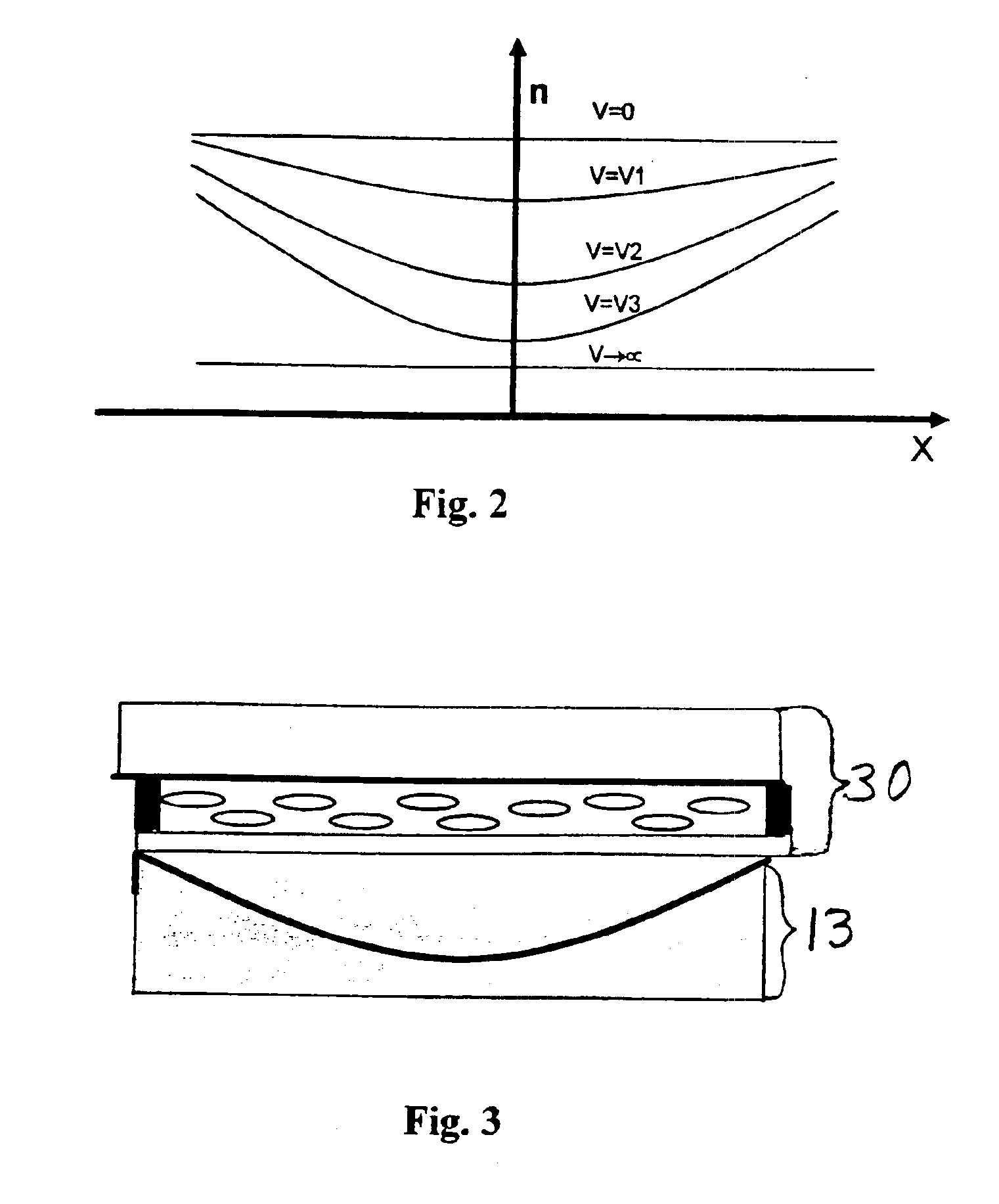Adaptive liquid crystal lenses
a liquid crystal lens and liquid crystal technology, applied in the field of adaptive liquid crystal lenses, can solve the problems of ineffectiveness, and inability to adjust mechanical movements, and achieve the effect of sharp and clean images
- Summary
- Abstract
- Description
- Claims
- Application Information
AI Technical Summary
Benefits of technology
Problems solved by technology
Method used
Image
Examples
example 1
Positive Lens (Method 1)
FIGS. 1A-1C show the fabrication process for a positive lens. The concave surface of a lens 10 is coated with a transparent electrode 11, such as, indium-tin-oxide (ITO), as shown in FIG. 1A. Then, the concave valley 12 is filled with the same material of the lens or polymer to form a planar substrate 13, as shown in FIG. 1B. Depending upon the refractive index of the glass or polymer substrate, many types of transparent materials, such as UV curable pre-polymer NOA65, NOA81 available from Norland Optical Adhesives, Edmund Industrial Optics, 101 East Gloucester Pike, Barrington N.J., 08007-1380, NOA65: L36-426, NOA81: L 36-428 or thermal cured polymer, or other similar materials can be chosen.
After filling the concave valley with transparent material, the planar substrate 13 is combined with another planar substrate 14 to confine the liquid crystal (LC) layer 15. The inner surface of substrate 14 is also coated with a transparent electrode 16. Both inner surf...
example 2
Positive Lens (Method 2)
To simplify the lens fabrication processes, one can use a planar substrate 13 as shown in FIG. 1B to combine with a prepared LC cell 30, as shown in FIG. 3. Thus, to form a positive lens, a planar substrate having a concave lens surface with curved or concave electrode is positioned below the homogeneous nematic LC cell.
example 3
Polarization Independent Positive LC Lens
Using two concave lenses 41 and 42, and the similar fabrication processes as shown in FIG. 1, a first planar substrate 43, and a second planar substrate 44, are placed in a parallel arrangement with each having a spherical electrode layer 45 and 46, as shown in FIG. 4. The first and second planar substrates comprise spherical or curved electrodes positioned to form a concave mirror image. Two homogeneous LC layers 47 and 48 in orthogonal alignment are positioned between the first and second planar substrates. If the top LC layer 47 causes the extraordinary ray to change focus, then the bottom LC layer 48 will change the focus of the ordinary ray. Thus, this kind of lens is polarization independent. It is highly desirable to have polarization independent lens. Otherwise, the lens needs to use a linear polarizer, which would reduce the transparency of the lens by at least 50%. There is a middle substrate 49 made of transparent material, as show...
PUM
| Property | Measurement | Unit |
|---|---|---|
| transparency | aaaaa | aaaaa |
| voltage | aaaaa | aaaaa |
| focal length | aaaaa | aaaaa |
Abstract
Description
Claims
Application Information
 Login to View More
Login to View More - R&D
- Intellectual Property
- Life Sciences
- Materials
- Tech Scout
- Unparalleled Data Quality
- Higher Quality Content
- 60% Fewer Hallucinations
Browse by: Latest US Patents, China's latest patents, Technical Efficacy Thesaurus, Application Domain, Technology Topic, Popular Technical Reports.
© 2025 PatSnap. All rights reserved.Legal|Privacy policy|Modern Slavery Act Transparency Statement|Sitemap|About US| Contact US: help@patsnap.com



